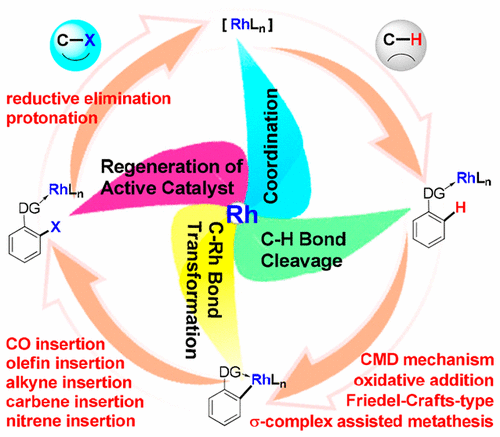当前位置:
X-MOL 学术
›
Acc. Chem. Res.
›
论文详情
Our official English website, www.x-mol.net, welcomes your
feedback! (Note: you will need to create a separate account there.)
Mechanism of Rhodium-Catalyzed C–H Functionalization: Advances in Theoretical Investigation
Accounts of Chemical Research ( IF 16.4 ) Pub Date : 2017-11-07 00:00:00 , DOI: 10.1021/acs.accounts.7b00400 Xiaotian Qi 1 , Yingzi Li 1 , Ruopeng Bai 1 , Yu Lan 1
Accounts of Chemical Research ( IF 16.4 ) Pub Date : 2017-11-07 00:00:00 , DOI: 10.1021/acs.accounts.7b00400 Xiaotian Qi 1 , Yingzi Li 1 , Ruopeng Bai 1 , Yu Lan 1
Affiliation

|
Transition-metal-catalyzed cross-coupling has emerged as an effective strategy for chemical synthesis. Within this area, direct C–H bond transformation is one of the most efficient and environmentally friendly processes for the construction of new C–C or C–heteroatom bonds. Over the past decades, rhodium-catalyzed C–H functionalization has attracted considerable attention because of the versatility and wide use of rhodium catalysts in chemistry. A series of C–X (X = C, N, or O) bond formation reactions could be realized from corresponding C–H bonds using rhodium catalysts. Various experimental studies on rhodium-catalyzed C–H functionalization reactions have been reported, and in tandem, mechanistic and computational studies have also progressed significantly.
中文翻译:

铑催化的CH功能化的机理:理论研究的进展
过渡金属催化的交叉偶联已经成为化学合成的有效策略。在该区域内,直接的C–H键转换是构建新的C–C或C–杂原子键的最有效,最环境友好的过程之一。在过去的几十年中,由于铑在化学上的多功能性和广泛用途,铑催化的CH的H官能化引起了相当大的关注。使用铑催化剂可以通过相应的C–H键实现一系列的C–X(X = C,N或O)键形成反应。关于铑催化的C–H官能化反应的各种实验研究已有报道,同时,机理和计算研究也取得了显着进展。
更新日期:2017-11-07
中文翻译:

铑催化的CH功能化的机理:理论研究的进展
过渡金属催化的交叉偶联已经成为化学合成的有效策略。在该区域内,直接的C–H键转换是构建新的C–C或C–杂原子键的最有效,最环境友好的过程之一。在过去的几十年中,由于铑在化学上的多功能性和广泛用途,铑催化的CH的H官能化引起了相当大的关注。使用铑催化剂可以通过相应的C–H键实现一系列的C–X(X = C,N或O)键形成反应。关于铑催化的C–H官能化反应的各种实验研究已有报道,同时,机理和计算研究也取得了显着进展。











































 京公网安备 11010802027423号
京公网安备 11010802027423号